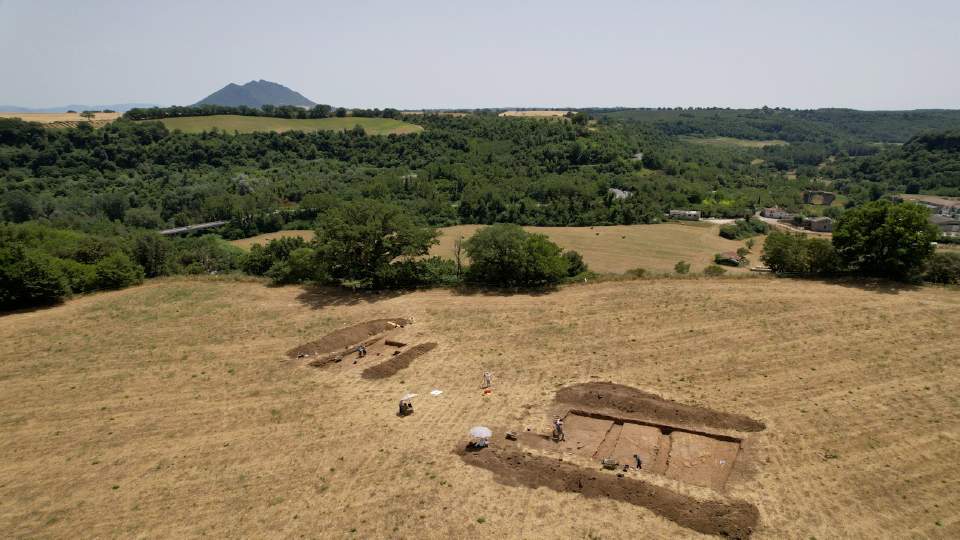Excavation campaign on Vignale hill concluded: here's what emerged
The excavation campaign on the Vignale hill(Civita Castellana), one of the two hills on which the ancient city stood, which has remained basically untouched by urbanization, has been concluded. The archaeological survey was conducted by the Department of Sciences of Antiquity of theUniversity of Rome “La Sapienza” (Teaching of Civilization of Pre-Roman Italy), in close collaboration with the Superintendence.
As Maria Cristina Biella, director of the archaeological mission, explains, the campaign is the result of a research process that has been going on for a long time: a search in museum deposits and archives that started fifteen years ago and has developed into successive non-invasive surveys, such as multispectral and thermal drone and georadar flights, and 2020 territorial reconnaissance, up to the recent excavations.
The operation was made possible only by funding from the CARIVIT Foundation and the Municipality of Civita Castellana. It started from a historical caesura date marked by 241 B.C., the moment of the Roman conquest and the trigger for the development of Falerii Novi (near today’s Santa Maria di Falleri, in the municipality of Fabrica di Roma). The objective was to investigate the process of structuring and management of a pre-Roman city after the Roman conquest.
Two excavation areas were worked on: one near the top of the hill and one closer to the slope. Georadar on the first revealed traces of agricultural activities, such as plowing from the 1880s and vineyard trenches from the 18th-19th centuries, but also an interesting structure made of tufa blocks, whose last phase of use dates back to between the 4th and 3rd centuries BC.
On the second excavation area, action was taken to confirm data from multispectral and thermal drone flights. Traces of in situ caving of blocks, plugging with monumental wall structures, pertinent to the city, as well as others referable to activities of earlier phases, when the urban settlement was still in formation, dating back to the Bronze Age and to a period between the 8th and early 6th centuries BCE, came to light under a substantial substructure.
Investigations have returned here after a long time, since Raniero Mengarelli surveyed the eastern portion of the hill in the late 19th century, finding the remains of the Vignale sanctuary, whose architectural decorations are now on display partly at the National Etruscan Museum of Villa Giulia and partly at the Archaeological Museum of Agro Falisco in Civita Castellana.
Collaboration with the latter was important for this reason. Central, however, was also the synergy with the Municipality of Civita Castellana, which also owns the land where the excavations took place. The municipality is implementing a process of valorization of the area: at the end of the 1990s it purchased the Vignale high ground to create a city park with a strong archaeological vocation. Not only has the municipality invested and is investing in this direction, but soon it will also sign a 10-year memorandum of understanding with the Department of Antiquity Sciences of the University of Rome “La Sapienza”; this will allow then to continue the investigations.
Looking to the future, work is already beginning, for example, on architectural structures, with targeted analysis on plaster fragments and building materials pertinent to the elevation of the structures, conducted in collaboration with the Department of Chemistry, Materials and Chemical Engineering “G. Natta” of the Politecnico di Milano.
Action will be taken on several fronts: not only laboratory campaigns during the winter season, at the Archaeological Museum of Agro Falisco, and the publication of the data, but also educational training, which will actively involve students of the three-year degree courses in Archaeological Sciences and master’s degree in Archaeology at La Sapienza, as well as local schools, in order to raise awareness and enthusiasm among young people to develop a sense of belonging.
Finally, the first contribution of the systematic edition in the Bulletin of Archaeology online, in agreement with the Central Institute for Archaeology, of the preventive archaeology surveys conducted between 1992 and 2010 by the then Archaeological Superintendence for Southern Etruria is being printed.
 |
| Excavation campaign on Vignale hill concluded: here's what emerged |
Warning: the translation into English of the original Italian article was created using automatic tools. We undertake to review all articles, but we do not guarantee the total absence of inaccuracies in the translation due to the program. You can find the original by clicking on the ITA button. If you find any mistake,please contact us.





























